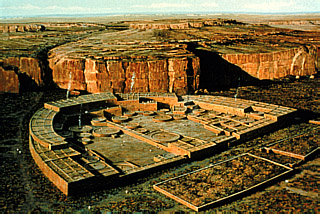CHACO CANYON, NEW MEXICO
Pueblo Bonito was the largest communal dwelling in pre-Columbian North America. There were over
600 rooms and over 36 Kivas (ceremonial meeting places). Pueblo Bonito was constructed in stages starting around 900 A.D. with the most extensive construction between 1075 A.D. to 1115 A.D. Thirty thousand tons
of stone and thousands of timbers spread out over 3 acres. If you would compare this to an apartment complex, you would not see anything of this size in North America until the end of the 1800s. At it's height, 1100 A.D., Chaco Canyon had a population of 2,000 to 6,000 people scattered over many communities, of which
Pueblo Bonito was the central and single largest community.
Chaco Canyon poses many questions. The question I ask is why live there? Building materials such as
timbers sometimes had to come from 30 miles away. Agriculture can be practiced but the arid climate makes
it a gamble. Despite their efforts at irrigation, it appears that local agriculture could only support about
2,000 people under optimum conditions. There is the argument that Chaco Canyon sustained itself by trade
with different cultures such as the Toltecs. The trade with the Toltecs centered around luxury goods such as turquoise exchanged for copper bells and Macaw feathers, but most experts believe that their economy could not have been sustained by such trade. Then there is the question of why so many rooms were built that do not appear to have been used. Most of the rooms have no hearths and many of the lower rooms were filled in to suport the rooms above. Also, analysis of their trash dumps gives evidence that Pueblo Bonito never had full occupancy, with perhaps only 100 people calling it a permanent home.

pictures
click
next.


